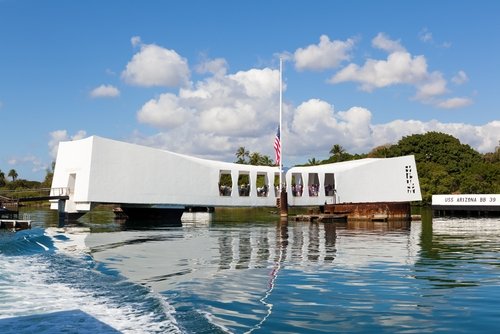USS Arizona preserved forever with the help of 3D laser scanning

With Memorial Day just past, historic battlegrounds and the like have once more come to the foreground of American minds – including the USS Arizona.
The USS Arizona is one of the most important U.S. historic sites from the Second World War. It was sunk by the Japanese during the attack on Pearl Harbor and is the resting place for 1,177 crewmen. A memorial currently rests above the mid-portion of the battleship, and has stood since 1961. Honolulu-based news source KITV reported 1.7 million people visit the site annually. However, the battleship still remains at the bottom of the ocean, which poses many challenges to researchers and historians who seek to learn more about the conditions of the ship when it went down.
Researchers and conservationists now have the ability to see the inside of the ship, as divers surveyed the wreck last year using 3D laser scanning technology. 3D models have recently been generated using the collected data sets of the battleship to bring history alive for future generations. Just last year, SmartGeoMetrics scanned the USS Missouri to help preserve the vessel for the future.
The beginning of a virtual museum
According to KITV, the National Park Service partnered with a technology company to scan the USS Arizona using LiDar Sonar. The park service then used the data sets, as well as photographs, to create 3D models of the USS Arizona. For the first time, everyday objects still sitting in the ship – from a soda bottle to a cooking pot – have once more seen the light of day through these virtual models.
Daniel Martinez, a historian and employee with the park service, said that these items help to showcase that this ship was home to many of the crewmen that went down in it, bringing the USS Arizona's story home to visitors. Hawaii News Now reported researchers haven't had a good look at the battleship for 30 years, and so the scanning professionals used multiple types of technologies, such as sonar and photo, to create the most accurate models.
According to Hawaii News Now, Martinez said 3D laser scanning and modeling holds many possibilities for the preservation of the site and the legacy of the USS Arizona.
"We could move forward with a virtual museum," Martinez said. "We could take the artifacts that we have in the museum and intertwine that with what we have for the ship."
In addition, Martinez said researchers will also now be able to measure how the ship is shifting on the bottom of the ocean. Researchers can use this data as a baseline for their future conservation efforts, as Martinez noted there is biological growth on the battleship and the conditions on the bottom of the Pacific can continue to change, affecting the USS Arizona.
For those who survived the sinking of the USS Arizona and are still living, the technology gives them hope that future generations of Americans won't forget what happened at Pearl Harbor and how the Second World War impacted the everyday lives of Americans.
To learn more about how laser scanners help preserve historic vessels, check out how SmartGeoMetrics' mapped the USS Missouri last year.
Historical sites: Learn how SGM can bring cutting edge technology to bear on presenting your historical site to visitors in ways never before seen with our 3D imaging services.
